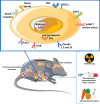EO771, is it a well-characterized cell line for mouse mammary cancer model? Limit and uncertainty
- PMID: 33026171
- PMCID: PMC7643677
- DOI: 10.1002/cam4.3295
EO771, is it a well-characterized cell line for mouse mammary cancer model? Limit and uncertainty
Abstract
Among mouse mammary tumor models, syngeneic cell lines present an advantage for the study of immune response. However, few of these models are well characterized. The tumor line EO771 is derived from spontaneous breast cancer of C57BL/6 mice. These cells are widely used but are referenced under different names: EO771, EO 771, and E0771. The characteristics of the EO771 cells are well described but some data are contradictory. This cell line presents the great interest of developing an immunocompetent neoplastic model using an orthotopic implantation reflecting the mammary tumors encountered in breast cancer patients. This review presents the phenotype characteristics of EO771 and its sensitivity to nutrients and different therapies such as radiotherapy, chemotherapy, hormone therapy, and immunotherapy.
Keywords: antineoplastic agents; breast neoplasms; hormonal receptors; inbred C57BL; mice; murine cell line.
© 2020 The Authors. Cancer Medicine published by John Wiley & Sons Ltd.
Conflict of interest statement
The authors declare that they have no conflict of interest.
Figures

References
-
- Winters S, Martin C, Murphy D, Shokar NK. Breast cancer epidemiology, prevention, and screening. Prog Mol Biol Transl Sci. 2017;151:1‐32. - PubMed
-
- Mouse Genome Sequencing Consortium . Initial sequencing and comparative analysis of the mouse genome. Nature. 2002;420(6915):520‐562. - PubMed
-
- Stewart TJ, Abrams SI. Altered immune function during long‐term host‐tumor interactions can be modulated to retard autochthonous neoplastic growth. J Immunol. 2007;179(5):2851‐2859. - PubMed
-
- Sugiura K, Stock CC. Studies in a tumor spectrum. I. Comparison of the action of methylbis (2‐chloroethyl)amine and 3‐bis(2‐chloroethyl)aminomethyl‐4‐methoxymethyl ‐5‐hydroxy‐6‐methylpyridine on the growth of a variety of mouse and rat tumors. Cancer. 1952;5(2):382‐402. - PubMed
Publication types
MeSH terms
Substances
LinkOut - more resources
Full Text Sources
Other Literature Sources
Medical
Research Materials

